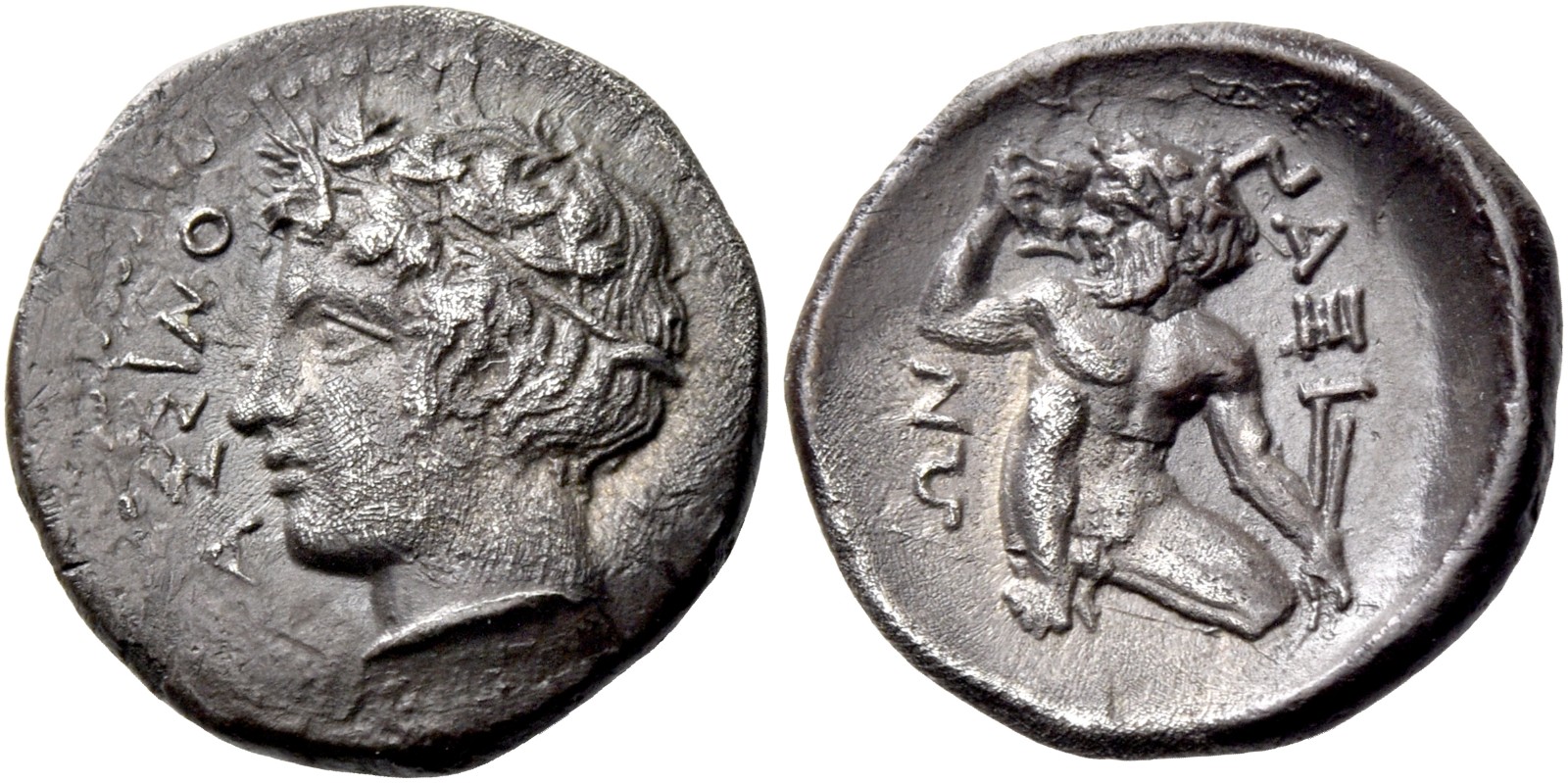AC 82 - Naxus, silver, hemidrachms (413-404 BCE)
From SILVER
413 BCE - 404 BCE Silver 252 kg
Description
| ObverseInscription or printing placed on the obverse.: | AΣΣINOΣ (Greek).Ivy-wreathed head of river-god l. |
| ReverseInscription or printing placed on the reverse.: | NAΞIΩN (Greek).Silenus squatting l., holding cantharus in r. hand and branch in l. |
Mint and issuing power
| MintIdentifies the place of manufacture or issue of a numismatic object.: | Naxus | Ancient regionAncient region.: | Sicily | Modern countryModern country: Italy | AuthorityIdentifies the issuing power. The authority can be "pretended" when the name or the portrait of X is on the coin but he/she was not the issuing power. It can also be "uncertain" when there is no mention of X on the coin but he/she was the issuing power according to the historical sources: |
Chronology
| FromIdentifies the initial date in a range assigned in a numismatic context. | 413 BCE | toIdentifies the final date in a range assigned in a numismatic context.. | 404 BCE | PeriodTime period of the numismatic object.: Classical 480-323 BC |
Physical description
| MetalThe physical material (usually metal) from which an object is made.: | Silver |
Median weightMedian of the weights of numismatic objects (in grams). in grams | 2.05 | DenominationTerm indicating the value of a numismatic object. Examples: tetradrachm, chalkous, denarius.: | hemidrachm |
StandardStandard.: |
Image

AC 82 - Naxus, silver, hemidrachms (413-404 BCE).jpg [1]
References
| Die study referencePublication of the study: | Cahn 19441Cahn 1944, p. 138-140, n° 115-128. | ||
| Coin series referenceReference to coin series study: | Sear I2Sear I, n° 878, RQEMAC3RQEMAC, n° 82 | ||
Obverse dies distribution
| FrequencyFrequency of specimen in distribution. ᵖ | Number of obversesNumber of obverse dies. ᵖ (o) | % (o) | Number of coinsNumber of coins. (n) | % (n) | Die nameName(s) of the die(s). |
| 2 | 3 | 50 | 6 | 11.11 | 74, 75, 78 |
| 8 | 1 | 16.67 | 8 | 14.81 | 77 |
| 10 | 1 | 16.67 | 10 | 18.52 | 76 |
| 30 | 1 | 16.67 | 30 | 55.56 | 73 |
| Total | 6 of 6 | 100.01 | 54 of 54 | 100 |
Reverse dies distribution
no distribution is available
Quantification
| Number of obversesNumber of obverse dies. ᵖ (o) | 6 | Number of singletons (o1)The number of singleton coins. ᵖ | |
| Number of reverse diesNumber of reverse dies. (r) | 9 | Number of coinsNumber of coins. (n) | 54 |
| Coins per obverse dieNumber of coins per obverse die. (n/o) | 9 | Coins per reverse dieNumber of coins per reverse die. (n/r) | 6 |
| Reverse per obverse ratioRatio of obverse dies divided by reverse dies. (r/o) | 1.5 | Percentage of singletons (o1)number of coins (n) divided by the number of singletons (o1) ᵖ | % |
| Original number of dies (O) (Carter 1983 formula)The estimation of the number of coins according to Carter 1983 ᵖ | 6.15 | Coins struck if 20,000 as average productivity per dieCoins made if the average productivity for obverses (according to Carter) is 20,000. ᵖ | 123,000 |
| Original number of dies (O) (Esty 2011 formula)The estimation of the number of coins according to the singleton formula in Esty 2011 ᵖ (O) | 6.75 | Survival rate if 20,000 as average productivity per dieSurvival rate if average productivity is 20,000. ᵖ | 0.00044 |
| Coverage (o = % of O) (Esty 1984 formula)Esty 1984 - coverage (% of O) ᵖ (o = % of O) | % | Die productivity if survival rate 1/2,000Average productivity if survival rate is 1/2,000. ᵖ | 17,560.98 |
| Weight of silver (in kg) if 20,000 coins per die (O = Carter formula)Carter 1983 * Median weight * 20000 (*10 if gold or electrum) ᵖ | 252 kg <br /> 252 kg | Die productivity if survival rate 1/5,000Average productivity if survival rate is 1/5,000. ᵖ | 43,902.44 |
Remarks
Most likely one single workstation